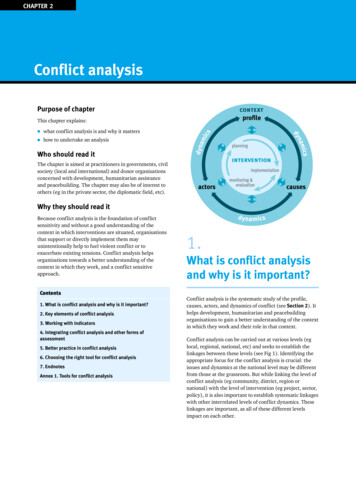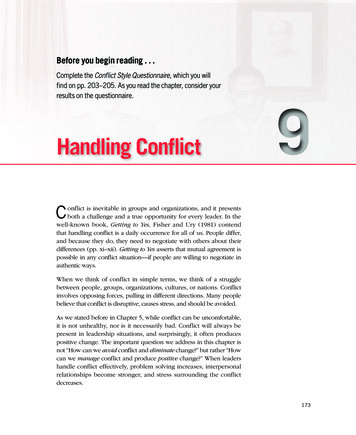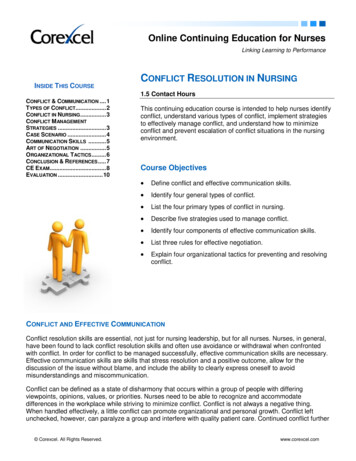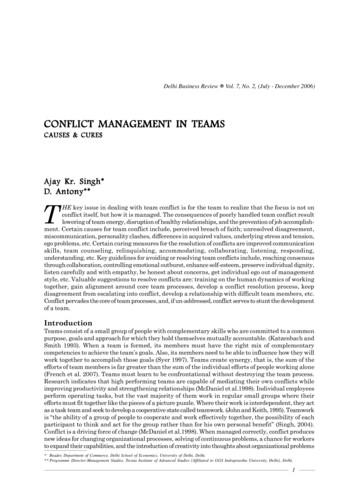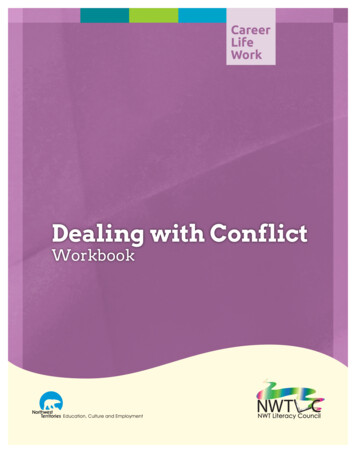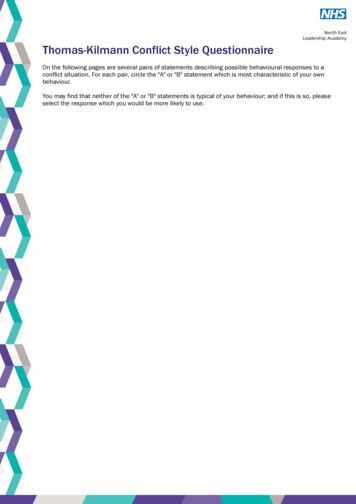
Transcription
THE DONBAS CONFLICT AS A FORM OF HYBRID WARFARE: ANEOCLASSICAL REALIST ANALYSISA THESIS SUBMITTED TOTHE GRADUATE SCHOOL OF SOCIAL SCIENCESOFMIDDLE EAST TECHNICAL UNIVERSITYBYIBRAHIM MURADOVIN PARTIAL FULFILLMENT OF THE REQUIREMENTSFORTHE DEGREE OF DOCTOR OF PHILOSOPHYINTHE PROGRAMME OF INTERNATIONAL RELATIONSSEPTEMBER 2019
Approval of the Graduate School of Social SciencesProf. Dr. Yaşar KondakçıDirectorI certify that this thesis satisfies all the requirements as a thesis for the degree ofDoctor of Philosophy.Prof. Dr. Oktay F. TanrıseverHead of DepartmentThis is to certify that we have read this thesis and that in our opinion it is fullyadequate, in scope and quality, as a thesis for the degree of Doctor of Philosophy.Prof. Dr. Oktay F. TanrıseverSupervisorExamining Committee MembersProf. Dr. Nuri Yurdusev(METU, IR)Prof. Dr. Oktay F. Tanrısever(METU, IR)Prof. Dr. Fırat Purtaş(Gazi U., IR)Assoc. Prof. Dr. Sevilay Kahraman(METU, IR)Assist. Prof. Dr. Onur İşçi(Bilkent U., IR)
PLAGIARISMI hereby declare that all information in this document has been obtained andpresented in accordance with academic rules and ethical conduct. I also declarethat, as required by these rules and conduct, I have fully cited and referencedall material and results that are not original to this work.Name, Last name : IBRAHIM MURADOVSignatureiii:
ABSTRACTTHE DONBAS CONFLICT AS A FORM OF HYBRID WARFARE: ANEOCLASSICAL REALIST ANALYSISMuradov, IbrahimPh.D., Department of International RelationsSupervisor: Prof. Dr. Oktay F. TanrıseverSeptember 2019, 414 pagesThe Euromaidan demonstrations in Ukraine which occurred at the end of 2013provoked destabilization of Donbas region. Despite several initiatives there has beenno lasting solution to the conflict in Donbas for the past 5 years. This research seeksto answer the question, that which factors could explain the outbreak and the conductof the war in Donbas territory of Ukraine? In this context, this work broadens ourunderstanding on the Donbas Conflict by revealing the internal factors of Ukraine aswell as Russia’s involvement in the conflict through hybrid war method. Contrary tothe current views of some researchers who point out either domestic dynamics ofUkraine or international factors to explain the conflict in Donbas, this thesis arguesthat Russia as an external actor should be taken into consideration along with thedomestic factors of Ukraine to provide holistic standpoint in studying the conflict.Keywords: Ukraine, Donbas Conflict, Russia, Hybrid Warfare, NeoclassicalRealism.iv
ÖZHİBRİD SAVAŞ ÖRNEĞİ OLARAK DONBAS ÇATIŞMASI: NEOKLASİKREALİST BİR ANALİZMuradov, İbrahimDoktora, Uluslararası İlişkiler BölümüTez Yöneticisi: Prof. Dr. Oktay F. TanrıseverEylül 2019, 414 sayfaUkrayna’da 2013 yılının sonlarına doğru gerçekleşen Euromaidan gösterileri Donbasbölgesinin istikrarsızlaştırılmasını tetiklemiştir. Birkaç girişime rağmen, son 5 yılboyunca Donbas’ta yaşanan çatışmaya kalıcı bir çözüm bulunamamıştır. Buaraştırma, Ukrayna’nın Donbas bölgesindeki savaşın ortaya çıkmasını veyürütülmesini açıklayabilecek hangi faktörlerin olduğu sorusuna cevap vermeyeçalışıyor. Bu bağlamda, çalışma, Rusya’nın hibrit savaş yöntemiyle çatışmaya dahilolmasının yanı sıra Ukrayna’nın iç faktörlerini de ortaya koyarak Donbas Çatışmasıkonusundaki anlayışımızı genişletiyor. Ukrayna’nın yerel dinamikleri �n mevcut görüşlerinin aksine, bu tez, soruna bütünsel bir yaklaşımsağlamak için Rusya’nın bir dış aktör olarak Ukrayna’nın yerel faktörleriyle birliktegöz önüne alınması gerektiğini savunuyor.Anahtar Kelimeler: Ukrayna, Donbas Çatışması, Rusya, Hibrit Savaş, NeoklasikRealizm.v
DEDICATIONTo my nieces and nephewsvi
ACKNOWLEDGMENTSThe author wishes to express his deepest gratitude to his supervisor Prof. Dr. OktayF. Tanrısever for his guidance, encouragements, criticism, advice, and insightthroughout this PhD research.The author would also like to thank Prof. Dr. Nuri Yurdusev, Prof. Dr. Faruk Yalvaç,Prof. Dr. Fırat Purtaş, Assoc. Prof. Dr. Sevilay Kahraman, and Assist. Prof. Dr. Onurİşçi for their suggestions and comments.The author shows his deepest gratitude to his companion Diana Rud-Volha for hertechnical assistance in formatting this dissertation and for her persistent support andencouragements along the way.Additionally, the author would like to thank his fellow doctoral students, UzairHashmi and Oktay Tuncer as well as Assoc. Prof. Dr. Mariia Mikheichenko for theirfeedback, cooperation, and invaluable insight during this PhD studies.Besides, the author would like to thank, Amjad Iqbal, Aslı Bozkurt, Ece Adıgüzel,Özgün Ersin and Serhat Keskin for their support, encouragements and of coursefriendship.Last but not the least, the author would like to thank his family: his parents, YasinMuradov and Gülyeter Muradova and his sisters, Leyla, Lale, Zarina, Mina, Sabinaand his only brother, Ismayıl for supporting him spiritually throughout this PhDstudies and his life in general.And finally, the author would like to thank Presidency for Turks Abroad and RelatedCommunities (YTB) for funding this PhD research.vii
TABLE OF CONTENTSPLAGIARISM . iiiABSTRACT . ivÖZ. vDEDICATION . viACKNOWLEDGMENTS . viiTABLE OF CONTENTS . viiiLIST OF TABLES . xiiLIST OF PICTURES . xiiiLIST OF ABBREVIATIONS . xivCHAPTER1. INTRODUCTION . 11.1. Scope and Objective: Significance of the Research . 11.2. Research Question . 21.3. Literature Review . 31.4. Main Argument. 151.5. Theoretical Framework and Methodology . 151.6. Plan of the Thesis . 172. THEORETICAL FRAMEWORK . 202.1. Introduction . 202.2. The Concept of Hybrid War . 212.2.1. Origin of New War Debate and Hybrid War . 212.2.2. Hybrid War and Its Evolution . 35viii
2.3. Alternative Approaches to Hybrid War . 412.3.1. Classical Realism . 412.3.2. Structural Realism. 542.3.3. Liberal Approach . 632.3.4. Neoclassical Realism and Its Strength . 712.4. Conclusion . 783. HISTORICAL EVOLUTION OF UKRAINE AND DONBAS . 803.1. Introduction . 803.2. Kievan Rus’ . 803.3. The Treaty of Pereyaslav and the Division of Ukraine . 843.4. The Emergence of Donbas Region . 913.5. Conclusion . 994. POLITICAL DEVELOPMENTS IN UKRAINE AFTER THE INDEPENDECEAND THEIR IMPACT ON DONBAS . 1014.1. Introduction . 1014.2. Politics in Ukraine from Independence to Orange Revolution . 1014.3. Evaluation of Orange Revolution In Connection with Donbas Territory . 1074.4. Developments Towards Euromaidan . 1114.5. Political Formations in Donbas before the ‘DPR’ and the ‘LPR’ . 1244.5. Annexation of Crimea . 1314.6. Conclusion . 1465. MILITARY ASPECT OF THE DONBAS WAR . 1485.1. Introduction . 1485.2. From Seizing the Buildings to Full-Fledged War . 1495.3. August 2014: The Hottest Month of the Donbas War . 1625.4. Second Stage of the War: After the Minsk-I Protocol . 167ix
5.5. The Clashes after the Minsk-II . 1765.6. The Crisis of Kerch Strait . 1795.7. Conclusion . 1836. NON-MILITARY ASPECTS OF THE DONBAS CONFLICT . 1846.1. Introduction . 1846.2. Political Developments after Euromaidan . 1856.2.1 Post-Euromaidan Developments in Ukraine . 1856.2.2 Governance of the ‘DPR’ and the ‘LPR’ . 2056.3. Economic Dimension . 2166.3.1 Structure of Donbas Economy . 2176.3.2 Economic Consequences of Donbas Conflict . 2246.4. Information War . 2346.4.1 Information War before the Donbas Conflict . 2356.4.2 Russia’s Information War against Ukraine . 2466.4.3. How Ukraine Deals with Russia’s Information Campaign . 2576.5. Cyber Attacks . 2666.6. Conclusion . 2737. DONBAS CONFLICT AND PEACE PROCESS . 2757.1. Introduction . 2757.2. Trilateral Contact Group and Minsk-I Protocol . 2757.3. Minsk II Agreement. 2847.5. Minsk Agreements and Russian Federation . 2947.6. The UN Peacekeeping Mission in Donbas . 2997.7. Conclusion . 3048. COMPARING THE UKRAINIAN WAR WITH GEORGIAN WAR . 306x
8.1. Introduction . 3068.2. Georgian-Russian War . 3078.2.1 Background of the War . 3078.2.2. Military Aspect . 3108.2.3. Political Aspect . 3148.2.4. Economic Aspect . 3198.2.5. Information Warfare . 3238.2.6. Cyber Attack . 3308.9. Conclusion . 3329. CONCLUSION . 334REFERENCES. 344APPENDICES . 393A. CURRICULUM VITAE . 393B. TURKISH SUMMARY/ TÜRKÇE ÖZET . 395C. TEZ FOTOKOPİSİ İZİN FORMU . 414xi
LIST OF TABLESTABLESTable 1. Gerasimov’s Definition of Traditional and New Military Methods . 38Table 2. The Share of Donbas in the Volume of Ukraine’s Export . 231Table 3. Decline of Donbas Export Volume . 232Table 4. Russian and Ukrainian Proposals of UN Peacekeeping Mission in Donbas. 301xii
LIST OF PICTURESPICTURESPicture 1 An Election Campaign Poster during 2004 Presidential Election in Ukraine. 127Picture 2 Putin’s Novorossiya . 130Picture 3 Anti-terrorist Operation by Sectors. . 153Picture 4 Highway Map of Ukraine . 157Picture 5 The Situation in Donbas on August 13, 2019 . 164Picture 6 Kerch Strait . 180Picture 7 Dynamics of Leaders Ratings (May 2018-February 2019) . 200Picture 8 Defaced Image of Viktor Yushchenko during 2004 Presidential Election inUkraine . 239Picture 9 A Provocative Headline in Golos Donbassa . 240Picture 10 Stop Fascism! Everybody to Referendum! . 251Picture 11 “Make Your Choice”. . 253Picture 12 A Photograph Used by Russian Trolls as A Propaganda Tool . 256Picture 13 Some of Banned Books in Ukraine. 261xiii
LIST OF ABBREVIATIONSAAAssociation Agreement with the European UnionARCAutonomous Republic of CrimeaATOAnti-terrorist OperationCECCentral Election CommissionCIACentral Intelligence AgencyCISCommonwealth of Independent StatesCPSUCommunist Party of the Soviet UnionCUCustoms UnionDDoSDistributed Denial of ServiceDonbasDonets BasinDPRDonetsk People’s RepublicEaPEastern PartnershipEPEuromaidan PressEUEuropean UnionFSBFederal Security ServiceGDPGross Domestic ProductGSSRGeorgian Soviet Socialist RepublicICCAInternational Council Commercial ArbitrationIDPInternally Displaced PeopleIMFInternational Monetary FundIRInternational RelationsIRInformation ResistanceJCCCJoint Monitoring and Coordination CenterKhPRKharkov People’s RepublicLPRLugansk People’s RepublicMANPADSMan-portable Air-defense SystemsMDFMedia Development FoundationNGONon-governmental OrganizationOSCEOrganization for Security and Cooperation in Europexiv
OUNOrganization of Ukrainian NationalistsRCCRussian Community of CrimeaRFRussian FederationRPGRocket-propelled GrenadeRMARevolution in Military AffairsRSFSRRussian Soviet Federative Socialist RepublicSBUSecurity Service of UkraineSMMSpecial Monitoring MissionUAHUkrainian HryvniaUCMCUkraine Crisis Media CenterUNUnited Nations OrganizationUNRUkrainian National RepublicUOCUkrainian Orthodox ChurchUSAUnited States of AmericaUSSRUnion of Soviet Socialist RepublicsWWIWorld War IWWIIWorld War IIWTOWarsaw Treaty Organization4GWFourth Generation Warfarexv
CHAPTER 1INTRODUCTION1.1. Scope and Objective: Significance of the ResearchIt was expected a radical transformation in political, cultural and social structures ofpost-Soviet countries right after the disintegration of the Soviet Union. In this regard,by leaving Soviet heritage behind, transition to free market economy and developingdemocracy were the major prospects in early 1990s in these countries. After theobservations of political transformations of post-Soviet countries, the EU has startedits own initiatives to integrate these countries into Western world. In this context,Ukraine is particularly in the spotlight since Orange Revolution and Euromaidanevents. Even though the EU has made substantial effort for this project, anticipateddevelopments have not occurred yet in Ukraine. In contrast, political structure of thecountry went from bad to worse after destabilization of the eastern part of thecountry.Researchers tend to explain the conflict in Ukraine either from the point ofinternational systemic view or from internal dynamics of Ukraine. The former groupmainly focus on the impact of Russia’s attitude on the conflict in Eastern Ukrainewhile the latter concentrates historical and sociological developments to reveal thecauses of the crisis. The significance of this research appears in this stage that itbroadens our understanding by combining two perspectives. On one hand, the studyclarifies the origin of Donbas conflict by scrutinizing historical developments and thereconstructing of the ‘Donbas exclusiveness’ since the independence of Ukraine. Onthe other hand, the research pays attention to the external factors to grab the origin ofthe conflict in Donbas. In this sense, the thesis concentrates on the concepts of hybridwar which is conducted by Russia against Ukraine. Hence, this dissertation aims toprovide a comprehensive research on Donbas Conflict. Particularly the research aimsto clarify the reasons behind the conflict and evaluates it within new war debates.1
1.2. Research QuestionThe Euromaidan demonstrations which occurred at the end of 2013 provokeddestabilization of Eastern Ukraine. After annexation of Crimea by RussianFederation, the Donbas territory became new focal point of the crisis in Ukraine.Since 2014, the war in Donbas constitutes one of the main political, economic andsocial problems in the country. Despite several initiatives there has been no lastingsolution to the conflict in Donbas for the past 5 years. In this period, two selfproclaimed ‘republics’ have been established in the territory that Ukraine blamesRussia in supporting those ‘republics’. Moscow however does not acknowledge itsinvolvement in the conflict. The experts who aim to analyze the causes of theconflict in Donbas mainly focus on the conflict either from the international systemiclevel or attempt to explain it by merely investigating the political dynamics ofUkraine. However, this thesis finds a research gap in both approaches and seeks toreveal the origin of the war in Donbas and attempts to answer the question, thatwhich factors could explain the outbreak and the conduct of the war in Donbas?By investigating the factors which had impact on the destabilization of Donbas inconnection to the form of war chosen to fight in the territory, this research seeks toresponse how the conflict in Donbas revealed and how it is being conducted?Questioning the form of war in Donbas helps us to understand external dimension ofthe war. Therefore, this thesis first seeks to answer how the war in Donbas is beingconducted? Subsequently it questions the factors which paved the way for the war inEastern Ukraine. This study particularly questions the milestones in the history ofUkraine which had a great impact on the formulation of Donbas regional identity.The thesis also answers that which political developments in Ukraine from 1991 to 2004including Orange Revolution played critical role in preparing the basis for outbreakof the war in Donbas. Besides, scrutinizing the Euromaidan events and theircontribution on the destabilization of Eastern Ukraine is another central questionwhich has been attempted to be answered. In this sense, revealing the impact of antiRussian Euromaidan demonstrations particularly after the seizure of Crimea issignificant to comprehend the beginning of the conflict in Donbas. This thesis furtheraims to explore non-military aspects of the war in Donbas. Questioning these aspects2
ensure to understand whole dimensions of the conflict in Ukraine. The research alsoattempts to inquire which obstacles the Donbas territory is experiencing to achieveresolution of the conflict.In order to put the subject in further perspective, a similar conflict to Donbas in postSoviet space has been taken as a unit for comparison to clarify the origin of theDonbas conflict. This is important to understand the reasons which kept the conflictlast so long and exploring this will enlighten us about the gaps left by previousresearch in this area of study.1.3. Literature ReviewUkraine’s crisis which began with the Euromaidan demonstrations at the end of 2013and sparked off the annexation of Crimea and the destabilization of Eastern regionsof the country has been explained from numerous angles. As a protracted war,ongoing conflict in Donetsk and Lugansk regions of Ukraine (Donbas) constitute themain sources of the Ukraine’s crisis. Besides, along with the impact of the conflicton internal politics of Ukraine the influence of the conflict in Donetsk and Luganskregions goes beyond the borders of the country. Therefore, it can be seen thatscholars’ approaches in evaluating the subject are becoming increasingly various. Inthis regard, scholars can be divided mainly into three camps. The first group includesscholars who consider the issue as a Russia’s war against Ukraine. The second groupapproaches to the subject from the view of internal politics of Ukraine. The lastgroup argues that the conflict in the Eastern regions of Ukraine originates from thedevelopments in international order.Andrew Wilson is one of the prominent scholars who discusses the origin of Donbasconflict in relation with Russia’s involvement. In his book titled ‘Ukraine Crisis:What It Means for the West’1 Wilson claims that contrary to what Russianpropaganda labeled the ousting of Yanukovych as a coup d’état in Kyiv in 2014, theactual coup was taken place in Crimea conducted by Kremlin. However, Moscow’s1Andrew Wilson, Ukraine Crisis: What It Means for the West (New Haven and London: YaleUniversity Press, 2014).3
calculation about Donbas was a misadventure which caused the destabilization of theregion. In the book, the author explains Russia’s involvement in Donbas conflictthrough numerous factors such as Putin’s personality, ‘humiliation’ of Russia due tothe collapse of Soviet Union or enlargement policy of North Atlantic TreatyOrganization (NATO). In an article named ‘The Donbas in 2014: Explaining CivilConflict Perhaps, but not Civil War’2 Andrew Wilson emphasizes the role of Russiain ongoing conflict in Eastern Ukraine. For Wilson, ‘accomplishments’ of separatistsin Donetsk and Lugansk regions of Ukraine could not be possible without Russia’ssupport. In their co-authored work, ‘What will Happen with Eastern Ukraine?’3Andrew Wilson and Kadri Liik argue that Moscow aims to overhaul the post-ColdWar order in Europe and tend to decide the fate of Ukraine in order to achieve thisaim.Taras Kuzio is another leading scholar who productively contributes the literature onUkraine and thereby Donbas conflict. Kuzio also links the source of the conflict inEastern Ukraine to Russian federation (RF). However, he claims that Moscow’sattitude against Ukraine arises from national identity issue. In his book, ‘Putin’s WarAgainst Ukraine: Revolution, Nationalism, and Crime’4 Kuzio claims that identityrelations between Russians and Ukrainians as well as Russian chauvinism towardsUkraine lie at the heart of Donbas conflict. In particular, the scholar underlines thatthe revival of Russian nationalism and Moscow’s refusal of recognizing Ukraine as asovereign state are the main reasons behind Russia’s war against Ukraine. Alongwith Kuzio, Timothy Snyder is another scholar who explains the Ukraine crisis inrelation with ideology. In the article ‘The Battle in Ukraine Means Everything’5Snyder draws attention to the rise of fascism in Russia based on the hatred againstthe ‘Western values’ and also refusal of the recognition of Ukraine as a sovereigncountry. For example, Russian propagandists during and after the EuromaidanAndrew Wilson, “The Donbas in 2014: Explaining Civil Conflict Perhaps, but Not Civil War,”Europe-Asia Studies 68, no. 4 (2016): 631–52, dri Liik and Andrew Wilson, “What Will Happen With Eastern?,” Policy Memo, vol. 119, 2014.Taras Kuzio, Putin’s War Against Ukraine: Revolution, Nationalism, and Crime (CreateSpaceIndependent Publishing Platform, 2017).4Timothy Snyder, “The Battle in Ukraine Means Everything,” The New Republic, 2014, accessed July23, 2019, urns-ukraine.54
demonstrations, were emphasizing the argument ‘Ukraine has never existed’ or‘Ukraine was always a part of Great Russia’. Thus, for Snyder, the main reason ofthe conflict in Donbas lies at the rising fascism in Russia.In his book titled ‘The Conflict in Ukraine: What Everyone Needs to Know’6 SerhyYekelchyk also explains conflict in Donetsk and Lugansk regions of Ukraine inrelation with Russia. According to Yekelchyk, the main reasons behind Russia’sinvolvement in war with Ukraine are Russians’ unwillingness to recognize Ukraineas a separate country out of their sphere of influence and the ideology of the Putinregime which promises to protect Russian speakers or ethnic Russians abroad.Another scholar is Sabine Fischer who pays attention to the role of Russia’s foreignpolicy in destabilization of Donbas region. For Fischer, conflict in Eastern Ukraine isthe last circle of unresolved conflicts in post-Soviet space. In her work, ‘RussianPolicy in the Unresolved Conflicts’7 Fischer agrees with the argument that Russia is arevisionist actor to the European order established after ending the Cold War.Additionally, she points out that Moscow follows ‘selective revisionism’ in terms ofpost-Soviet conflicts since the dynamics of the conflicts vary from each other.In searching the origin of the conflict in Donbas, Ihor Todorov also takes Russia as amain actor which supports the separatist forces in Eastern Ukraine. In his articlenamed ‘Sources of Modern Russian-Ukraine War: Donetsk Dimension’8 Todorovargues that Moscow is not merely organizer but also the executer of the conflict inDonbas. For Todorov, Russia had two options either to follow a system providessocial welfare or to become an imperialist power. The author points out that Russiadecided to adopt the latter option with Putin, and this is the main reason behind waragainst Ukraine.Stefan Meister is also among the scholars who associates the conflict in Ukraine toRussian Federation. Meister directly sees the Putin regime as a main source of the6Serhy Yekelchyk, The Conflict in Ukraine: What Everyone Needs to Know (New York: OxfordUniversity Press, 2015).Sabine Fischer, “Russian Policy in the Unresolved Conflicts,” SWP-Studie 13 (2016): 9–24, accessedJuly 23, 2019, en-conflicts-in-the-post-soviet-area/.7Ihor Todorov, “Sources of Modern Russian-Ukraine War: Donetsk Dimension,” Zeszyty NaukoweAon 3, no. 100 (2015): 27–31.85
Russian aggression in Ukraine. In his article ‘Fünf Illusionen über das System Putin’9(Five Illusions about the Putin System) Meister states tha
Approval of the Graduate School of Social Sciences Prof. Dr. Yaşar Kondakçı Director I certify that this thesis satisfies all the requirements as a thesis for the degree of Doctor of Philosophy. Prof. Dr. Oktay F. Tanrısever Head of Department This is to certify that we have read this thesis and that in our opinion it is fully


